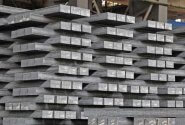Ingots in the Iranian market are still associated with price inflammation. In the market on Saturday, the average price of ingots in all sales portals of rivals was equal to 118450 Rials, which was not stable and reached 115833 Rials by the weekend.
We start with the export of steel industries. There is a lot of controversy these days about the performance of steelmakers in the field of exports, and most analysts acknowledge that the issue of steel exports, especially crude sales, should be reconsidered in the current situation and steel export policies should be There were changes in the structure. The current problem of steelmakers is the lack of a clear procedure in the country’s exports.
*** Export Challenges of Steel and Iron Ore
At a time when the supply of raw materials for the steel industry is facing deep challenges and the speed of production is facing an unprecedented slowness, the choice of export scenario will definitely hit the domestic market and result in price inflammation in long sections and steel ingots. It will be a hot topic these days for artisans, but it shows one aspect of Iran’s steel export market. In the current situation, steelmakers have been able to compete in the international market with great difficulty and sometimes find international customers for their products. But with the termination of the steel export order, the credit and customers of these companies will be easily lost.
*** Problem of raw material supply and wrong policy in steel export
Regarding the problem of raw material supply, analyzes have been proposed before, the answer to which was to solve the problem with a long-term view and supply materials from the stockpiles of accumulated warehouses in other industries. But what is the problem of the steel industry today is the issue of steel exports, which since 1992, when it was originally planned, has always been associated with problems and obstacles and has created challenges for production.
Despite capacity building in the steel sector and overproduction in the last decade, proper export policies have not been created, and some policymakers have diverted the market by raising issues such as export promises and export incentives. On the other hand, companies with high costs have been able to find global customers, and by interrupting the export process on an orderly basis, in the current situation of domestic companies, they will suffer heavy losses.
*** Challenge of half exchange rate and free market differences
Another issue that has become a challenge for steel exports is the difference between the free market currency price and the Nima currency. Since some of the producers’ dollar incomes have to be returned to the Nima system. The different rates of this system and the difference between the price of the currency and the domestic market cause a serious decrease in the steelmaker’s profit and are considered as a kind of hidden tax, and this causes the steel producer to look for other ways not to return the export currency.
*** Assess the situation of domestic iron ore production
The production of iron ore concentrate in domestic flax companies has increased by 4% in the first six months of this year. This amount has increased by six percent compared to the same period last year, and in September of this year, Iran’s iron ore production was estimated at about 4 million tons. Golgohar, Chadormelo, Middle East Mining and Mining Industries, Gohar Zamin and Markazi companies have recorded the best performance.
It is necessary to explain that the volume of iron ore granulation production this year has decreased by 50% compared to the same period last year. The price of iron ore in the international market has reached its highest level this year, reaching $ 130 per tonne in September. The cost price of steel is expected to follow this price peak with a quarterly delay and increase prices in a cross-sectional period.
*** Predict the decline in domestic iron ore demand
As the weather cools, domestic iron ore demand is likely to decline, and this is likely to be exacerbated by a shortage of crude steel demand. Therefore, it is predicted that the performance of iron ore producers is at its best and their sales volume will decrease over time. Evaluation of prices in the iron ore export market shows that the latest price of 61% pure magnetite iron ore was $ 75.6 per ton FOB and 61% pure Iranian hematite iron ore export was $ 73.5 per ton FOB.
*** Evaluation of Iranian steel production
Ingots in the Iranian market are still associated with price inflammation. In the market on Saturday, the average price of steel ingot in all sales portals of rivals was equal to 118450 Rials, which was not stable and reached 115833 Rials by the weekend. The reason for this price decline was the daily fall in the price of the dollar, which is not a stable indicator of the end of bullion exchange rate fluctuations because the dollar has experienced many fluctuations in the past month and its definite path can not be predicted in the short term.
Another important reason for the temporary drop in bullion prices was China’s golden holidays and falling global bullion prices. This made the ingot arbitrage not economical and therefore helped reduce the price of steel ingots. The third issue that led to the reduction in the price of steel ingots was the lack of price support for the sections. Usually, with the increase of section rates, steel ingots also experienced upward changes, but in the market last week, long sections experienced stable days.
*** Government support for the export of final products
The government is trying to stop the sale of crude steel by supporting the development of exports of final products, and on the other hand, to use the final product produced as a tool to control supply and demand in the Iranian Commodity Exchange. Therefore, the cross-sectional support of the government for the base prices in the commodity exchange also reduced the price of steel ingots.
*** Assess the condition of steel sections
Regarding the price of sections, the market assessment of stability and sometimes the decline in the value of steel sections reported. For example, the average price of rebar last week from 131267 Rials to 128481 Rials It fell and factories preferred to sell their products at base commodity prices. An important issue regarding the price of sections is the ceiling of section steel prices in the commodity exchange. We will most likely see a price correction in the long steel section in the coming days as the market needs this correction.
According to the calculations of rebar steel analysts, something equal to 11% more than the calculation formula of the price of ingots should be sold on the commodity exchange. Therefore, the market is waiting for the rebar price to enter the bottom of its channel to buy. This is the most logical scenario for rollers to wait and focus on the watch price list. Because in a situation where the market is declining, buying rolling is likely to stop. So this week we will most likely see a drop in rolling prices.
این مطلب بدون برچسب می باشد.












ثبت دیدگاه